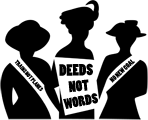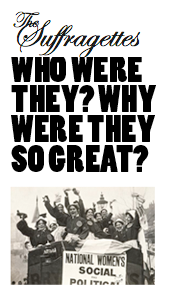History of The Suffragettes
Follow @ClimateRush
The 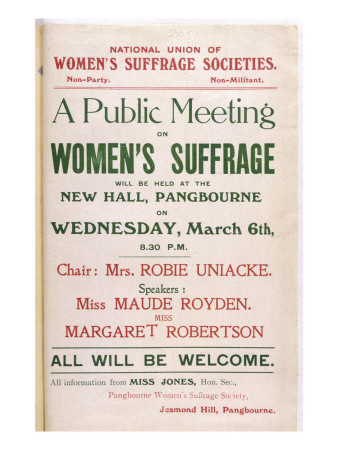 campaign for women’s suffrage in the UK went through many stages before becoming the radical direct action movement that resulted in women getting the vote in 1918. Since the mid 19th century, women had been lobbying the government for votes. By 1897, the women’s movement had organized itself into the National Union of Women’s Suffrage Societies (NUWSS), who ran a campaign of letter-writing, introduced Parliamentary Bills, and held public meetings to explain and promote their aims. After six years, frustrated little progress had been made, a group decided to split off from the NUWSS to form the Women’s Social and Political Union (WSPU), an all-women organisation who sought new and creative ways to get the social change they urgently needed.
campaign for women’s suffrage in the UK went through many stages before becoming the radical direct action movement that resulted in women getting the vote in 1918. Since the mid 19th century, women had been lobbying the government for votes. By 1897, the women’s movement had organized itself into the National Union of Women’s Suffrage Societies (NUWSS), who ran a campaign of letter-writing, introduced Parliamentary Bills, and held public meetings to explain and promote their aims. After six years, frustrated little progress had been made, a group decided to split off from the NUWSS to form the Women’s Social and Political Union (WSPU), an all-women organisation who sought new and creative ways to get the social change they urgently needed.
The politicians hadn’t been taking notice of the burgeoning women’s movement, and the WSPU decided it was time to stop being ignored. Members started disrupting public meetings of MPs and ministers, standing up and making speeches demanding the vote, or, 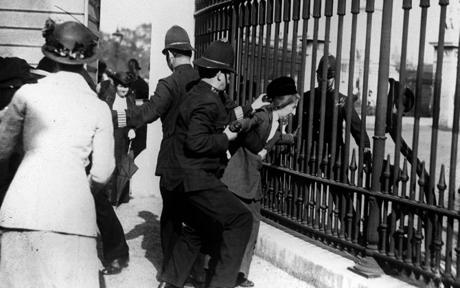 better yet, chaining themselves to their chairs so they couldn’t be removed. They started protesting inside the Houses of Parliament themselves, and when they couldn’t get to the people they wanted to talk to, they would find a way to sneak in. In January 1908 two suffragettes chained themselves to the railings to create a diversion while another attempted to infiltrate 10 Downing Street, and in February they attempted to enter the House by a “Trojan horse” method. But they also saw the need for a large and vibrant movement of women, and in the summer that year organised a huge demonstration in Hyde Park that was attended by over half a million people asking for social and political change. The mass demonstration got no results, and the WSPU had to escalate their tactics yet again.
better yet, chaining themselves to their chairs so they couldn’t be removed. They started protesting inside the Houses of Parliament themselves, and when they couldn’t get to the people they wanted to talk to, they would find a way to sneak in. In January 1908 two suffragettes chained themselves to the railings to create a diversion while another attempted to infiltrate 10 Downing Street, and in February they attempted to enter the House by a “Trojan horse” method. But they also saw the need for a large and vibrant movement of women, and in the summer that year organised a huge demonstration in Hyde Park that was attended by over half a million people asking for social and political change. The mass demonstration got no results, and the WSPU had to escalate their tactics yet again.
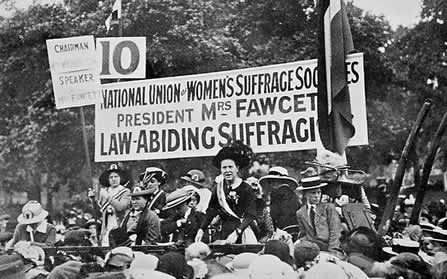
On October 13th 1908, 60,000 people (joined by 5,000 policemen) attended another rally in Parliament Square, but this time no one was satisfied with standing outside, unheard and ignored by those inside. At 7.30, groups of suffragettes tried to force their way past police lines to enter the House, and were arrested. During the course of the evening, a total of 37 arrests were made, and 10 people were taken to hospital. One woman managed to enter the floor of the House while debate was in progress, and said a few words before being taken out.
The Suffragettes were unstoppable. They consolidated their look, deciding to wear white (symbolising purity and truth) with  sashes reading ‘Votes for Women’ and a colour scheme of green and purple. They started publishing a newspaper, and founded their own press. They adopted the slogan ‘Deeds Not Words’. And, most spectacularly, an array of inventive direct action exploded into life. They poured jam and other concoctions into post boxes
sashes reading ‘Votes for Women’ and a colour scheme of green and purple. They started publishing a newspaper, and founded their own press. They adopted the slogan ‘Deeds Not Words’. And, most spectacularly, an array of inventive direct action exploded into life. They poured jam and other concoctions into post boxes  around the Bank of England and Downing Street to disrupt communication, they wrote on the MPs’ favourite golf courses in weedkiller (“No Votes, No Golf!”), they even waited outside Ministers houses and hit them with their umbrellas when they came out. Their greatest strength was persistence, making sure those who had the power to change their plight were as irritated, disrupted and put upon as women were who were forced to live as second class citizens. They disrupted more talks and meetings, one time throwing stones down on the roof of a building where the Prime Minister was speaking, making his speech inaudible, other times chanting and singing en masse in public meetings. Then, when they were arrested and imprisoned (which was often), they went on hunger strike. Even this constant presence was not quite enough. A campaign of window smashing was co-ordinated, targeting Oxford Street and Buckingham Palace, telegraph wires were cut, and several empty properties were set alight (harming no-one), in demonstration of the urgency of their demand.
around the Bank of England and Downing Street to disrupt communication, they wrote on the MPs’ favourite golf courses in weedkiller (“No Votes, No Golf!”), they even waited outside Ministers houses and hit them with their umbrellas when they came out. Their greatest strength was persistence, making sure those who had the power to change their plight were as irritated, disrupted and put upon as women were who were forced to live as second class citizens. They disrupted more talks and meetings, one time throwing stones down on the roof of a building where the Prime Minister was speaking, making his speech inaudible, other times chanting and singing en masse in public meetings. Then, when they were arrested and imprisoned (which was often), they went on hunger strike. Even this constant presence was not quite enough. A campaign of window smashing was co-ordinated, targeting Oxford Street and Buckingham Palace, telegraph wires were cut, and several empty properties were set alight (harming no-one), in demonstration of the urgency of their demand.
In 1914, at the height of their campaign, they suspended activities to concentrate their energy on the war effort. When the war ended in 1918, they won the vote.
